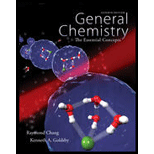
Concept explainers
(a)
Interpretation:
Names and
Concept introduction:
In chemistry, elements having similar chemical and physical properties are grouped together. According to Dalton’s atomic theory, elements are arranged according to their
(b)
Interpretation:
Names and symbols for four elements in each of the given categories have to be given.
Concept introduction:
In chemistry, elements having similar chemical and physical properties are grouped together. According to Dalton’s atomic theory, elements are arranged according to their atomic number in tabular arrangement. This table consists of vertical columns and horizontal row. Elements arranged in vertical columns called “groups” or “families” and elements in the horizontal row called “periods”. This tabular arrangement called “periodic table”.
(c)
Interpretation:
Names and symbols for four elements in each of the given categories have to be given.
Concept introduction:
In chemistry, elements having similar chemical and physical properties are grouped together. According to Dalton’s atomic theory, elements are arranged according to their atomic number in tabular arrangement. This table consists of vertical columns and horizontal row. Elements arranged in vertical columns called “groups” or “families” and elements in the horizontal row called “periods”. This tabular arrangement called “periodic table”.
Want to see the full answer?
Check out a sample textbook solution
Chapter 2 Solutions
General Chemistry
 ChemistryChemistryISBN:9781305957404Author:Steven S. Zumdahl, Susan A. Zumdahl, Donald J. DeCostePublisher:Cengage Learning
ChemistryChemistryISBN:9781305957404Author:Steven S. Zumdahl, Susan A. Zumdahl, Donald J. DeCostePublisher:Cengage Learning ChemistryChemistryISBN:9781259911156Author:Raymond Chang Dr., Jason Overby ProfessorPublisher:McGraw-Hill Education
ChemistryChemistryISBN:9781259911156Author:Raymond Chang Dr., Jason Overby ProfessorPublisher:McGraw-Hill Education Principles of Instrumental AnalysisChemistryISBN:9781305577213Author:Douglas A. Skoog, F. James Holler, Stanley R. CrouchPublisher:Cengage Learning
Principles of Instrumental AnalysisChemistryISBN:9781305577213Author:Douglas A. Skoog, F. James Holler, Stanley R. CrouchPublisher:Cengage Learning Organic ChemistryChemistryISBN:9780078021558Author:Janice Gorzynski Smith Dr.Publisher:McGraw-Hill Education
Organic ChemistryChemistryISBN:9780078021558Author:Janice Gorzynski Smith Dr.Publisher:McGraw-Hill Education Chemistry: Principles and ReactionsChemistryISBN:9781305079373Author:William L. Masterton, Cecile N. HurleyPublisher:Cengage Learning
Chemistry: Principles and ReactionsChemistryISBN:9781305079373Author:William L. Masterton, Cecile N. HurleyPublisher:Cengage Learning Elementary Principles of Chemical Processes, Bind...ChemistryISBN:9781118431221Author:Richard M. Felder, Ronald W. Rousseau, Lisa G. BullardPublisher:WILEY
Elementary Principles of Chemical Processes, Bind...ChemistryISBN:9781118431221Author:Richard M. Felder, Ronald W. Rousseau, Lisa G. BullardPublisher:WILEY





